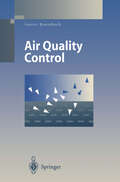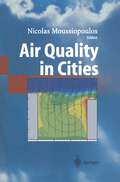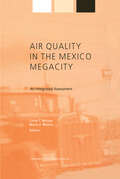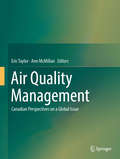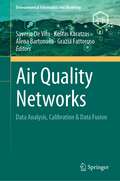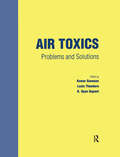- Table View
- List View
Air Quality Control: Formation and Sources, Dispersion, Characteristics and Impact of Air Pollutants — Measuring Methods, Techniques for Reduction of Emissions and Regulations for Air Quality Control (Environmental Science and Engineering)
by G. BaumbachAir quality and air pollution control are tasks of international concern as, for one, air pollutants do not refrain from crossing borders and, for another, industrial plants and motor vehicles which emit air pollutants are in widespread use today. In a number of the world's expanding cities smog situations are a frequent occurrence due to the number and emission-intensity of air pollution sources. Polluted air causes annoy ances and can, when it occurs in high concentrations in these cities, constitute a seri ous health hazard. How important clean air is to life becomes apparent when consid ering the fact that humans can do without food for up to 40 days, without air, how ever, only a few minutes. The first step towards improving the air quality situation is the awareness that a sound environment is as much to be aspired for as the development of new tech nologies improving the standard of living. Technical progress should be judged es pecially by how environmentally benign, clean and noiseless its products are. Of these elements, clean air is of special concern to me. I hope that this book will awaken more interest in this matter and that it will lead to new impulses. Due to the increasing complexity of today's machinery and industrial processes science and technology can no longer do without highly specialized design engineers and opera tors. Environmental processes, however, are highly interdependent and interlinked.
Air Quality in Cities
by Nicolas MoussiopoulosUrban areas are major sources of air pollution. Pollutant emissions affecting air quality in cities are considered to have adverse consequences for human health. Public and government concern about environmental issues arising from urban air pollution has increased over the last decades. The urban air pollution problem is widespread throughout the world and it is important to find ways of eliminating or at least reducing the risks for human health. The fundamentals of the physical and chemical processes occurring during air pollutant transport in the atmosphere are nowadays understood to a large extent. In particular, modelling of such processes has experienced a remarkable growth in the last decades. Monitoring capabilities have also improved markedly in the most urban areas around the world. However, neither modelling nor monitoring can solve urban air pollution problems, as they are only a first step in improving useful information for future regulations. The defining of efficient control strategies can not be achieved without a clear knowledge of the complete pollution process, i.e. emission, atmospheric transport and transformation, and deposition at the receptor. Improving our ability to establish valid urban scale source-receptor relation ships has been the objective of SA TURN, one of the 14 subprojects of EURO TRAC-2. Similar to the other subprojects of this co-ordinated environmental pro ject within the EUREKA initiative, SA TURN brought together international groups of scientists to work on problems directly related to atmospheric chemistry and physics. The present volume summarises the scientific results of SATURN.
Air Quality in the Mexico Megacity: An Integrated Assessment (Alliance for Global Sustainability Bookseries #2)
by Mario J. Molina Luisa T. MolinaIn this book, experts in atmospheric sciences, human health, economics, social and political sciences contribute to an integrated assessment of the complex elements needed to structure air quality policy in the 21st century. The analysis is developed through a case study of the Mexico City Metropolitan Area - one of the world's largest megacities in which air pollution grew unchecked for decades. The international research team is led by Luisa T. and Mario J. Molina, Nobel Laureate in Chemistry. Improvements in Mexico City's air quality in the last decade testifies to the power of determined and enlightened policy making, and throws into relief the tough problems that remain to be solved.The volume's first six chapters, including the contributions of over 50 distinguished scholars from Mexico and the US, outline the fundamental areas of knowledge policy makers must accommodate. The message is that only good science and well-chosen technologies can direct the way to corrective regulatory measures; but without strong commitment from government, no amount of science or technology can help.
Air Quality Integrated Assessment: A European Perspective (SpringerBriefs in Applied Sciences and Technology)
by Giorgio Guariso Marialuisa VoltaThis book is open access under a CC BY 4.0 license.This book reports on the results of an extended survey conducted across Europe within the framework of the APPRAISAL FP7 project to determine the extent to which an integrated assessment approach to air quality is being adopted, on the one hand, by regional and local authorities to develop air quality plans and, on the other, by researchers. Following a detailed analysis of the role and structure of the components of an integrated assessment study, the results of the survey are considered from a variety of perspectives. Above all, the book discusses the new light the survey sheds on emission abatement policies and measures planned at regional and local scales, and on their synergies/trade-offs with measures implemented at the national scale. Detailed consideration is given to the currently available modeling methodologies for identifying emission sources, assessing the effectiveness of emission reduction measures, and evaluating the impacts of emission abatement measures on human health. Current strengths and weaknesses revealed by the survey are explored, and the application of an integrated assessment tool in two case studies (in Brussels and Porto) is discussed. The book will appeal to all those interested in the use of integrated assessment in connection with the sources, effects and control of air pollution.
Air Quality Management: Canadian Perspectives on a Global Issue
by Eric Taylor Ann McMillanThis book provides a wide overview of the issues related to managing of air quality in Canada. Learn about the air issues that have caused impacts to ecosystems or human health and hence been targeted to be managed. Discover how Canada’s national governance involving a federal government along with provincial and territorial governments impacts the air quality management process. Understand how Canadians manage their air quality in context with the USA, their largest and closest neighbour. Benefit from the experience of 43 of Canada’s most experienced air quality management professionals who share their insights into the state of air quality in Canada today, how it is managed, as well as giving a glimpse into the future.
Air Quality Networks: Data Analysis, Calibration & Data Fusion (Environmental Informatics and Modeling)
by Saverio De Vito Kostas Karatzas Alena Bartonova Grazia FattorusoThis volume offers expert contributions proposing new and recently set scientific standards for smart air quality (AQ) networks data processing, along with results obtained during field deployments of pervasive and mobile systems. The book is divided into 5 main sections; 1) future air quality networks, 2) general data processing techniques, 3) field deployments performances, 4) special applications, and 5) cooperative and regulatory efforts. The authors offer different sources of data for the production of trustworthy insights, including spatio-temporal predictive AQ maps meant to boost citizen awareness, and informed participation in remediation and prevention policies. Readers will learn about the best and most up-to-date practices for measuring and assessing air quality, while also learning about current regulatory statuses regarding air quality technology design and implementation. The book will be of interest to air quality regulatory agencies, citizen science groups, city authorities, and researchers and students working with air quality sensors and geostatistics.
Air-sea rescue helicopter (Large Print)
by RnibThe helicopter is viewed from the side with only one of its main wheels showing at the lower centre of the page, and with a tail wheel to its right. There is a locator dot shown, which will be at the top left of the page when the image is the right way up. The cockpit at the front is on the left of the page and the tail on the right. The long rotor blades stretch from the left of the page to the right, above the helicopter body. On the left of the body there are three cockpit windows, up from these is the engine grill. Up from the main wheel one of the helicopter's floats is shown and two more windows. To the right of these is the open hatch through which people are winched during rescue missions. Right from the hatch is another window. Above the hatch and single window is the radar dome on the top edge of the helicopter. At the far right of the page is the six bladed tail rotor.
Air-sea rescue helicopter (UEB Contracted)
by RnibThe helicopter is viewed from the side with only one of its main wheels showing at the lower centre of the page, and with a tail wheel to its right. There is a locator dot shown, which will be at the top left of the page when the image is the right way up. The cockpit at the front is on the left of the page and the tail on the right. The long rotor blades stretch from the left of the page to the right, above the helicopter body. On the left of the body there are three cockpit windows, up from these is the engine grill. Up from the main wheel one of the helicopter's floats is shown and two more windows. To the right of these is the open hatch through which people are winched during rescue missions. Right from the hatch is another window. Above the hatch and single window is the radar dome on the top edge of the helicopter. At the far right of the page is the six bladed tail rotor.
Air-sea rescue helicopter (UEB Uncontracted)
by RnibThe helicopter is viewed from the side with only one of its main wheels showing at the lower centre of the page, and with a tail wheel to its right. There is a locator dot shown, which will be at the top left of the page when the image is the right way up. The cockpit at the front is on the left of the page and the tail on the right. The long rotor blades stretch from the left of the page to the right, above the helicopter body. On the left of the body there are three cockpit windows, up from these is the engine grill. Up from the main wheel one of the helicopter's floats is shown and two more windows. To the right of these is the open hatch through which people are winched during rescue missions. Right from the hatch is another window. Above the hatch and single window is the radar dome on the top edge of the helicopter. At the far right of the page is the six bladed tail rotor.
The Air Spora: A manual for catching and identifying airborne biological particles
by Maureen E. Lacey Jonathan S. WestThis is an illustrated guide to trapping, identifying and quantifying airborne biological particles such as fungus, plant spores and pollen. Including a comprehensive review of what is in the air and detailing the historical development of theories leading to modern aerobiology, the book explains the fundamental processes behind airborne dispersal and techniques used to sample, identify and quantify biological particles. Includes photographs and 9 colour reproductions of paintings of airborne particles.
Air-Stable Inverted Organic Light-Emitting Diodes (SpringerBriefs in Applied Sciences and Technology)
by Katsuyuki Morii Hirohiko FukagawaThis concise volume provides an introduction to the working principles, design, and construction of air-stable inverted organic light-emitting diodes (OLEDs), which lead to the realization of practical flexible electronics. The first part of the book reviews the history of the three generations of inverted OLEDs: hybrid organic inorganic light-emitting diodes (HOILEDs), metal oxides and organic electron injection layer, describing the materials, fabrication techniques, device structure, applications, and technological challenges involved in each case. The second part of the book focuses on the carrier injection mechanism in OLEDs.The book will be of interest to students and researchers working on organic optoelectronics.
Air Toxics: Problems and Solutions
by Kumar GanesanThis timely new workbook is the result of a year-long effort by a group of university professors who first met at Montana Tech during the summer of 1994 for a college faculty workshop. The workshop was funded by the National Science Foundation's support for those faculty developing courses in the newly emerging field of air toxics. Part I of the book contains over 100 problems dealing with a variety of topics in this area. Part II provides detailed solutions. The problems and solutions provided will become a useful resource for the training of engineers and scientists who are or soon will be working in the field.
Air Toxics: Problems and Solutions
by Kumar GanesanThis timely new workbook is the result of a year-long effort by a group of university professors who first met at Montana Tech during the summer of 1994 for a college faculty workshop. The workshop was funded by the National Science Foundation's support for those faculty developing courses in the newly emerging field of air toxics. Part I of the book contains over 100 problems dealing with a variety of topics in this area. Part II provides detailed solutions. The problems and solutions provided will become a useful resource for the training of engineers and scientists who are or soon will be working in the field.
Air Traffic Control Automated Systems (Springer Aerospace Technology)
by Bestugin A.R. Eshenko A.A. Filin A.D. Plyasovskikh A.P. Shatrakov A.Y. Shatrakov Y.G.This book highlights operation principles for Air Traffic Control Automated Systems (ATCAS), new scientific directions in design and application of dispatching training simulators and parameters of ATCAS radio equipment items for aircraft positioning. This book is designed for specialists in air traffic control and navigation at a professional and scientific level. The following topics are also included in this book: personnel actions in emergency, including such unforeseen circumstances as communication failure, airplane wandering off course, unrecognized aircraft appearance in the air traffic service zone, aerial target interception, fuel draining, airborne collision avoidance system (ACAS) alarm, emergency stacking and volcanic ash cloud straight ahead.
Air, Water and Soil Quality Modelling for Risk and Impact Assessment (Nato Security through Science Series C:)
by Adolf Ebel Teimuraz DavitashviliThis book contains the proceedings of the NATO Advanced Research Workshop on Air, Water and Soil Quality Modelling for Risk and Impact Assessment. The aim of the workshop was to further joint environmental compartment modelling and applications of control theory to environmental management. It provides an overview of ongoing research in this field regarding assessment of environmental risks and impacts.
Airborne Biocontaminants and their Impact on Human Health
by Rajeev Singh Anamika SinghExplore in-depth the relationships between biological contaminants and human health found in diverse settings such as homes, hospitals, businesses, and schools Indoor air quality has an immense impact on human health and well-being. Indoor air environments can contain a huge range of biological contaminants, including bacteria, fungi, viruses, insects, and their various harmful byproducts. Indoor biocontamination has been under-studied as an aspect of public and occupational health, and there is an urgent need for an introduction to this vital subject. Airborne Biocontaminants and Their Impact on Human Health meets this need with a thorough, rigorous overview of major indoor airborne contaminants. Gathering and summarizing a huge range of data regarding biocontaminants in settings from homes to schools to workplaces, it investigates patterns of morbidity and their connections to major contaminants. The result is an essential tool in the broader fight for human health at home and elsewhere. Airborne Biocontaminants and Their Impact on Human Health readers will also find: Analysis of the indoor role of gases, particulate matter, and others Detailed coverage of contaminant byproducts including endotoxins, mycotoxins, volatile organic compounds, and more Methods for generating awareness and therefore reduced risk of exposure to harmful contaminants Airborne Biocontaminants and Their Impact on Human Health is ideal for researchers—biologists, environmentalists, civil and environmental engineers, industrial hygienists, safety regulators, and public health officials—interested in the area of biological contamination in different environments.
Airborne Biocontaminants and their Impact on Human Health
by Rajeev Singh Anamika SinghExplore in-depth the relationships between biological contaminants and human health found in diverse settings such as homes, hospitals, businesses, and schools Indoor air quality has an immense impact on human health and well-being. Indoor air environments can contain a huge range of biological contaminants, including bacteria, fungi, viruses, insects, and their various harmful byproducts. Indoor biocontamination has been under-studied as an aspect of public and occupational health, and there is an urgent need for an introduction to this vital subject. Airborne Biocontaminants and Their Impact on Human Health meets this need with a thorough, rigorous overview of major indoor airborne contaminants. Gathering and summarizing a huge range of data regarding biocontaminants in settings from homes to schools to workplaces, it investigates patterns of morbidity and their connections to major contaminants. The result is an essential tool in the broader fight for human health at home and elsewhere. Airborne Biocontaminants and Their Impact on Human Health readers will also find: Analysis of the indoor role of gases, particulate matter, and others Detailed coverage of contaminant byproducts including endotoxins, mycotoxins, volatile organic compounds, and more Methods for generating awareness and therefore reduced risk of exposure to harmful contaminants Airborne Biocontaminants and Their Impact on Human Health is ideal for researchers—biologists, environmentalists, civil and environmental engineers, industrial hygienists, safety regulators, and public health officials—interested in the area of biological contamination in different environments.
The Airborne Microparticle: Its Physics, Chemistry, Optics, and Transport Phenomena
by E. James Davis Gustav SchweigerIt has been thirty years since one of the authors (EJD) began a collaboration with Professor Milton Kerker at Clarkson University in Potsdam, New York using light scattering methods to study aerosol processes. The development of a relatively short-lived commercial particle levitator based on a modification of the Millikan oil drop experiment attracted their attention and led the author to the study of single droplets and solid microparticles by levitation methods. The early work on measurements of droplet evaporation rates using light scattering techniques to determine the size slowly expanded and diversified as better instrumentation was developed, and faster computers made it possible to perform Mie theory light scattering calculations with ease. Several milestones can be identified in the progress of single microparticle studies. The first is the introduction of the electrodynamic balance, which provided more robust trapping of a particle. The electrodynamic levitator, which has played an important role in atomic and molecular ion spectroscopy, leading to the Nobel Prize in Physics in 1989 shared by Wolfgang Paul of Bonn University and Hans Dehmelt of the University of Washington, was easily adapted to trap microparticles. Simultaneously, improvements in detectors for acquiring and storing light scattering data and theoretical and experimental studies of the interesting optical properties of microspheres, especially the work on morphology dependent resonances by Arthur Ashkin at the Bell Laboratories, Richard Chang, from Yale University, and Tony Campillo from the Naval Research Laboratories in Washington D. C.
Airborne Occupational Hazards in Sewer Systems
by Amy Forsgren Kristina BrinckSewer systems fall into the category "out of sight, out of mind" – they seldom excite interest. But when things go wrong with the air in the sewer system, they go very wrong. Consequences can be dramatic and devastating: sewer workers killed instantly by poisonous gas when they lift a sewer lid, or entire suburban blocks levelled by explosions. This book describes the atmospheric dangers commonly found in the sewer system. It provides easily-understood explanations of the science behind the hazards, combined with real-life examples of when things went dramatically wrong.
Airborne Occupational Hazards in Sewer Systems
by Amy Forsgren Kristina BrinckSewer systems fall into the category "out of sight, out of mind" – they seldom excite interest. But when things go wrong with the air in the sewer system, they go very wrong. Consequences can be dramatic and devastating: sewer workers killed instantly by poisonous gas when they lift a sewer lid, or entire suburban blocks levelled by explosions. This book describes the atmospheric dangers commonly found in the sewer system. It provides easily-understood explanations of the science behind the hazards, combined with real-life examples of when things went dramatically wrong.
Airborne Particulate Matter (The Handbook of Environmental Chemistry #4 / 4D)
by S. Biegalski I. Colbeck W. Holländer T. Kouimtzis P. Koutrakis S. Landsberger J. M. Pacyna S. N. Pandis C. Pilinis C. Samara E. Selin C. Sioutas A. I. ZouboulisAirborne particulate matter - especially aerosols, its origin, its impact on our environment, and its properties - has been of great scientific and public concern for many years. In this volume experts discuss in depth all relevant issues of airborne particulate matter, including the characterisation of aerosols by modern physical and chemical methods.
Airborne Particulate Matter: Source, Chemistry and Health
by Saurabh Sonwani Anuradha ShuklaThis book is about airborne particulate matter, sources, chemistry and health and contained a complete information about their emission source, transport, atmospheric chemistry, distribution at local, regional and global levels, and their level in indoor and outdoor settings. Primary and secondary particulate matters in the ambient atmosphere also describe in detail. Analytical techniques, statistical tools and mathematical models used in airborne particulate research is also described. This book also covers the important aspects of the particulate matter chemistry in atmosphere, and their adverse impact on plant and human health. A detailed insight about the harmful impact of airborne particulate matter (biogenic and anthropogenic both) on different human system is described in detail. The toxicological significance of particulate matter on human body was also mentioned. The mitigation, management and regulatory policies to control ambient particulate matter is also provided. This book is also written in simple language with helpful photographs, diagrams, tables and flowcharts which will make the reader comfortable in understanding the concepts a more relatively easier way. Overall, the present book is a valuable tool for students working in the fields of Atmospheric Science, Environmental Science, Biological Sciences, Epidemiology and Agriculture Science. This book also a unique resource for environmental consultants, researchers, policymakers and other professionals involved in air quality, plant and human health.
Airborne Wind Energy: An Overview of the Technological Approaches (Green Energy and Technology)
by Uwe AhrensThis book shows possible solutions to how a profitable energy supply can be implemented with almost no population resistance. Worldwide, more than 80 % of our energy needs are still covered by fossil fuels. Under these circumstances, can climate change still be stopped? Essential technologies for usage of wind energy with an emphasis on high-altitude wind utilization are presented. Airborne wind energy is one of the most promising technologies to enable a renewable energy turnaround in an economical way. The main problem of conventional renewable energy is the insufficient availability. To ensure a 100 % supply of renewable energy, enormous and very expensive storage capacities would have to be built up. How we can cover our entire energy needs (electricity, mobility and heat) in the future without fossil fuels, without risking the competitiveness of our economy, is shown in this book.
Airborne Wind Energy: Advances in Technology Development and Research (Green Energy and Technology)
by Roland SchmehlThis book provides in-depth coverage of the latest research and development activities concerning innovative wind energy technologies intended to replace fossil fuels on an economical basis. A characteristic feature of the various conversion concepts discussed is the use of tethered flying devices to substantially reduce the material consumption per installed unit and to access wind energy at higher altitudes, where the wind is more consistent.The introductory chapter describes the emergence and economic dimension of airborne wind energy. Focusing on “Fundamentals, Modeling & Simulation”, Part I includes six contributions that describe quasi-steady as well as dynamic models and simulations of airborne wind energy systems or individual components. Shifting the spotlight to “Control, Optimization & Flight State Measurement”, Part II combines one chapter on measurement techniques with five chapters on control of kite and ground stations, and two chapters on optimization. Part III on “Concept Design & Analysis” includes three chapters that present and analyze novel harvesting concepts as well as two chapters on system component design. Part IV, which centers on “Implemented Concepts”, presents five chapters on established system concepts and one chapter about a subsystem for automatic launching and landing of kites. In closing, Part V focuses with four chapters on “Technology Deployment” related to market and financing strategies, as well as on regulation and the environment.The book builds on the success of the first volume “Airborne Wind Energy” (Springer, 2013), and offers a self-contained reference guide for researchers, scientists, professionals and students. The respective chapters were contributed by a broad variety of authors: academics, practicing engineers and inventors, all of whom are experts in their respective fields.
Airbreathing Propulsion: An Introduction (Springer Aerospace Technology)
by Tarit BoseAirbreathing Propulsion covers the physics of combustion, fluid and thermo-dynamics, and structural mechanics of airbreathing engines, including piston, turboprop, turbojet, turbofan, and ramjet engines. End-of-chapter exercises allow the reader to practice the fundamental concepts behind airbreathing propulsion, and the included PAGIC computer code will help the reader to examine the relationships between the performance parameters of different engines. Large amounts of data have on many different piston, turbojet, and turboprop engines have been compiled for this book and are included as an appendix. This textbook is ideal for senior undergraduate and graduate students studying aeronautical engineering, aerospace engineering, and mechanical engineering.
